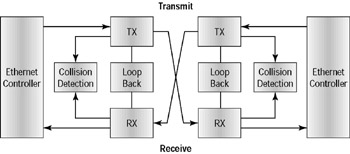Full-Duplex Ethernet
|
Full-duplex Ethernet can both transmit and receive simultaneously, but the node requires a dedicated switch port, not a hub, to be able to do so.
Full-duplex Ethernet uses point-to-point connections and is typically referred to as collision-free since it doesn’t share bandwidth with any other devices. Frames sent by two nodes cannot collide because there are physically separate transmitting and receiving circuits between the nodes.
If you have a full-duplex 10Mbps Ethernet operating bidirectionally on the same switch port, you can theoretically have 20Mbps aggregate throughput. Full-duplex Ethernet can now be used in 10BaseT, 100BaseT, and 100BaseFL media, but all devices (NICs, for example) must be able to support full-duplex transmission.
Half-Duplex Ethernet Design
Figure 2.16 illustrates the circuitry involved in half-duplex Ethernet. When a station is sending to another station, the transmitting circuitry is active at the transmitting station, and the receiving circuitry is active at the receiving station. This uses a single cable similar to a narrow one-way bridge.

Figure 2.16: Half-duplex circuitry
Full-Duplex Ethernet Design
Figure 2.17 illustrates full-duplex circuitry. Full-duplex Ethernet switch technology (FDES) provides a point-to-point connection between the transmitter of the transmitting station and the receiver of the receiving station. Half-duplex, standard Ethernet can usually provide up to 60 percent of the bandwidth available. In contrast, full-duplex Ethernet can provide a full 100 percent because it can transmit and receive simultaneously and because collisions don’t occur.
In order to run full-duplex Ethernet, you must have the following:
-
Two 10Mbps or 100Mbps paths
-
Full-duplex NICs
-
Loopback and collision detection disabled
-
Software drivers supporting two simultaneous data paths
-
Adherence to Ethernet distance standards
-
10BaseT/100BaseT: 100 meters
-
10BaseFL/100BaseFL: 2 kilometers

Figure 2.17: Full-duplex circuitry
|
EAN: 2147483647
Pages: 201